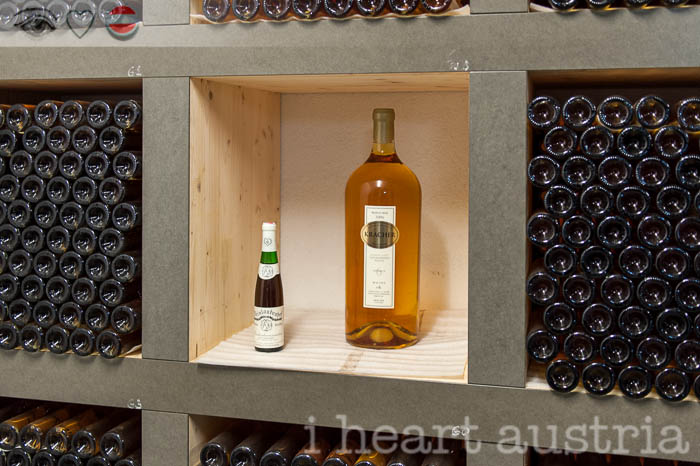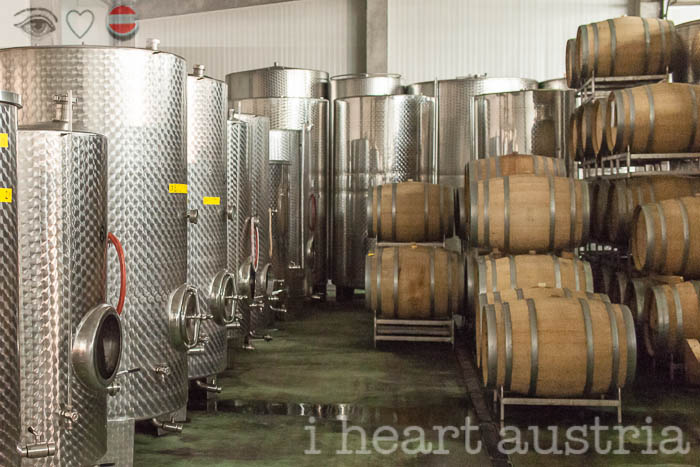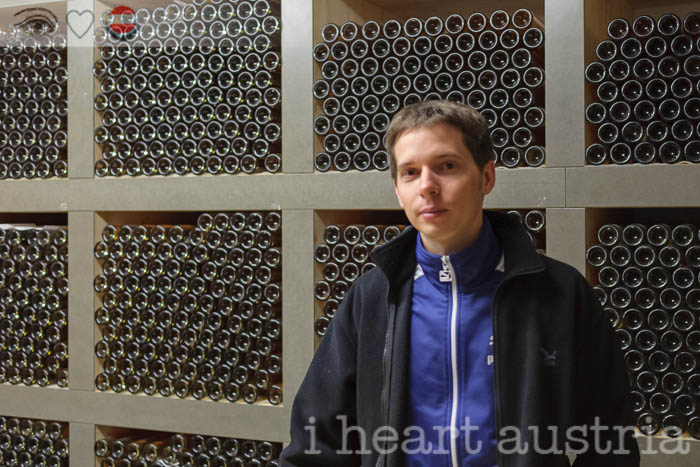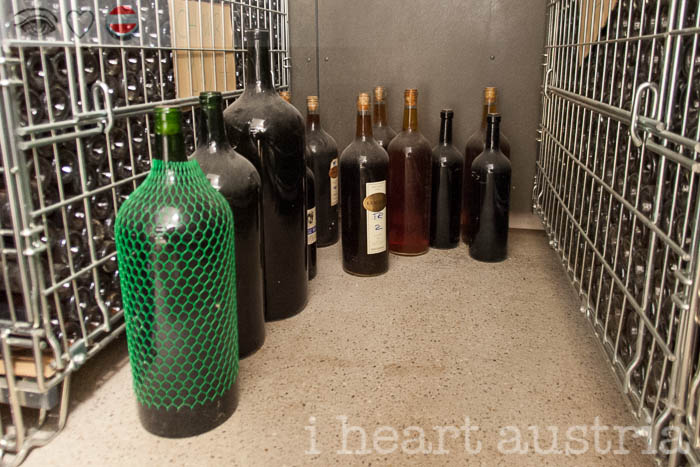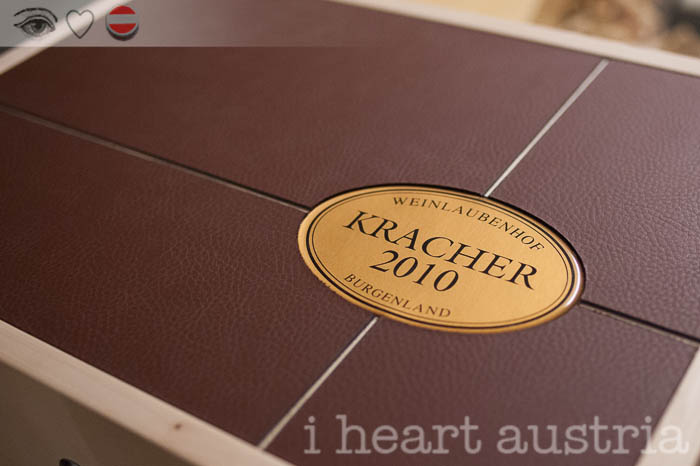Not many producers these days have older wines that are still on offer directly from the source. Their wines are either too popular, (selling out quickly each year), or the winery simply cannot afford to warehouse their inventory for years on end. Often this means that you will either end up with wine that is perhaps “too young” to drink, or if you are lucky and know just what you are looking for, that can only be found in the secondary wine market (auctions, private caches, dusty forgotten corners of wine shops, and such.) In Austria, Kracher is a notable and enviable exception.
Weinlaubenhof Kracher (“Weinlaubenhof” roughly translates to “grape arbor courtyard”) is renowned for their sweet wines. They call them “Dessertweine” and in Germany’s Mosel region, they would properly be called “Edelsüss”, or noble sweet. Their forte is above all wines that are designated “Trockenbeerenauslese” (TBA for short), wines that are at the highest level of sweetness and flavor concentration. “Trockenbeeren” refers to the grapes that are pressed for this wine, being “trocken” or dry, and in fact they more resemble raisins than grapes at this stage in their lives. Each may contain less than a drop of juice, making the resulting wines both precious and often, expensive.
Wines such as these often improve greatly with age, improving significantly over 10, 20, even 30 years, and can be enjoyable even much longer than that. Taking an enlightened approach, Kracher holds back 10% of the current year’s production for future release. Astonishingly, these wines will be sold for about the same original price. Although not every wine ever produced at Kracher is still for sale, the current price list includes more than 50 Trockenbeerenauslese wines dating back to 1998.
In fact the Kracher catalog includes many more wines than even that. In addition to dessert wines, they also produce a number of dry wines including white wine from Pinot gris, and red wine from Zweigelt, Merlot, Cabernet Sauvignon, and Blaufränkisch. The dry wines, I believe, you will never find in Amerika. While very competently made, they do not stand out in the same way as the sweet wines and will mostly be consumed in the local Austrian market.
Where’s the Riesling?
Unlike the sweet wines of Germany, in Austria no single grape variety dominates. Once upon time, the sweet wines of this region were primarily produced with Furmint (also known as Tocai Friulano) and Gelber Muskateller. Today the range of suitable grapes includes Chardonnay, Welschriesling, Pinot blanc, Gelber Muskateller, Muscat Ottonel, Sauvignon Blanc, Scheurebe, and Grüner Veltliner. Traditional, and simultaneously innovative seems to be a theme at the heart of Austrian culture.
A note about tasting notes: I’m not a big fan of traditional scoring and tasting notes. I tend to categorize wines as either a) those I would buy (or buy again) at a given price point or b) those I would not buy at that price; I vote for wines with my hard earned dollars (or euros, as the case may be.) I also am strong believer that wine tastes best in the proper context – whether during a meal, or with friends, and that simply tasting endless glasses of similar wine is an exercise best left to others.
All of these wines were excellent, and given that they cost significantly less in Austria then they do in U.S. (understandably due to the supply chain), they are a particularly good value. (Prices given in euros, 1 EU approx. = $1.30)
Wines we tasted (prices are for 375 ml except as noted, and include 20% sales tax)
Asterisk = irresistible and purchased. Honestly, they were all irresistible, but we only had room for a few!
Dry wines
Dry wines will typically range from 1 gram per liter to 6 grams per liter of residual sugar (g/l rs).
*2011 Pinot Gris (old vines, stainless) 1 g/l rs, 7 g/l acidity, 12.5% alc. 8.50€ (750ml)
Dessert wines
Sweet wines will typically be at least 45 g/l of residual sugar, but a key factor in the sense of sweetness is the total acidity level. Generally, acidity balances against sweetness. Alcohol level also plays a role in creating a harmonious and balanced wine.
2011 Cuvée Spätlese (50% Pinot gris, 45% Welschriesling, 5% Muskat Ottonel) Stainless. 49 g/l rs, 7 g/l acidity, 11.5% alc. 6.70€
2010 Cuvée Auslese (70% Welschriesling, 30% Chardonnay). 80 g/l rs, 7.3 g/l acidity, 12% alc. 8.60€
2009 Cuvée Beerenauslese (70% Welschriesling, 30% Chardonnay). 70% botrytis grapes, partial aging in oak (20%). Largest bottling. 114 g rs, 6.5 g/l acidity, 13% alc. 14.40€
2010 Cuvée Eiswein (30% Chardonnay, 30% Welschriesling, 40% Grüner Veltliner). 192 g/l rs, 8.4 g/l acidity, 11% alc. 28.40€
NV Trockenbeerenauslese (TBA) 187ml (2006, 2007, 2008)(55% Welschriesling, 40% Chardonnay, 5% Traminer). Some oak. Ideal for restaurant trade. 193 g/l rs, 8.2 g/l acidity, 10.5% alc. 11.50€
“Kollection” wines
The new 2010 “Kollection” wines had been released just prior to our visit. These wines are TBAs, numbered and ranked in terms of perceived sweetness. Each vintage may have as many as 12 or 13 bottlings depending on the harvest and vinification.
They follow two styles and are either designated Nouvelle Vague (NV) (new wave, meaning they undergo time in oak casks) or Zwischen den See (ZDS) (classic, meaning vinification and aging only in stainless steel vessels). Each year the entire collection is offered in a special edition containing one bottle of each variation. The special edition release for 2010 is priced at 500 EU.
*2010 #3 Scheurebe TBA ZDS. 215 g/l rs, 10.5 g/l acidity, 11% alc. 26€
*2010 #6 Grand Cuvée TBA NV. 204 g/l rs, 9.4 g/l acidity, 10.5% alc. 60% Chardonnay in new barrels, 40% Welschriesling in new 1000 liter oak casks. 30€
*2010 #11 Welschriesling TBA ZDS. 351 g/l rs, 13 g/l acidity, 6% alc. 35€
*1998 #7 Chardonnay/Welschriesling TBA NV. (50/50% in new oak). 196 g/l rs, 8 g/l acidity, 10% alc. High botrytis, outstanding year. 31€
+2008 #6 Grand Cuvée TBA NV. (70% Welschriesling, 30% Chardonnay). 212 g/l rs, 9.2 g/l acidity, 10.55 alc. Exceptional year. (38€)
Visit their website here: Weinlaubenhof Kracher (English)

